Bee balm tea is delicious and simple to make. In this post, I’ll give you my easy recipe, and show you step by step how to make bee balm tea using either fresh or dried monarda from your garden.
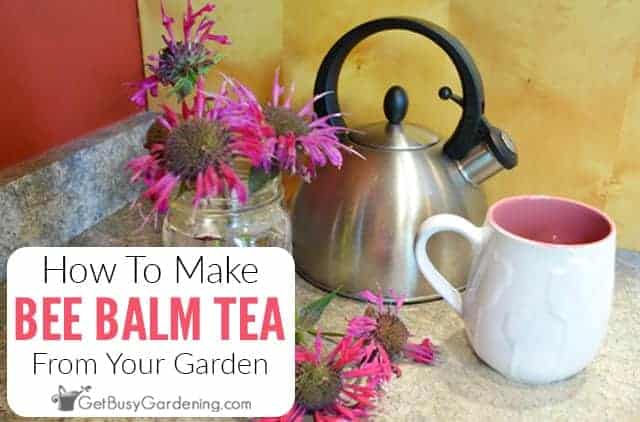
![]()
If you have monarda in your garden, you can make your own bee balm tea (also called wild bergamot, or oswego tea).
This beneficial tea not only tastes great, but is good for helping fight off colds and the flu. So it’s especially nice to have on hand in the winter months!
You can make it using either fresh or dried leaves and flowers, resulting in a soothing, mild minty drink to sip and enjoy.
Below I will tell you all about bee balm tea, and show you exactly how to make it using monarda from your garden.
What Does Bee Balm Tea Taste Like?
I really love the taste of bee balm tea. If you’ve never tried it, it has a slightly minty flavor. That makes sense since monarda is in the mint family, but the flavor is milder than other varieties.
What Part Of Bee Balm Is Used For Tea?
You can make bee balm tea using both the leaves and the flowers. The leaves have the strongest flavor, so that is what I prefer to use.
If you add in some of the flowers, it will turn your tea a lovely light pink or magenta color.
You can make it using freshly picked bee balm, or you can dry it first. If you want to keep some for later use, put it in a dehydrator, or lay it out on an herb drying rack.
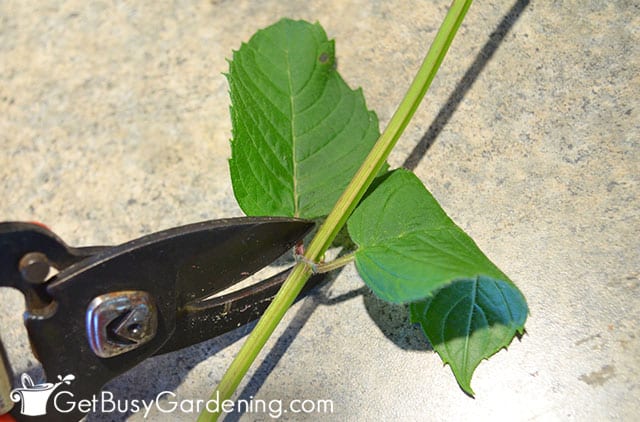
Clipping fresh leaves for oswego tea
When & How To Harvest Bee Balm For Tea
The best time to harvest bee balm for making tea is in the late spring, or early summer before the flowers start to fade. Simply clip or pinch healthy leaves and flowers from the plant.
Make sure you only use the healthy green ones though. Monarda leaves are very prone to powdery mildew, which presents as white spots or a coating on the leaves.
So discard any that have white spots, blemishes, are yellowing, or ones that show signs of powdery mildew.
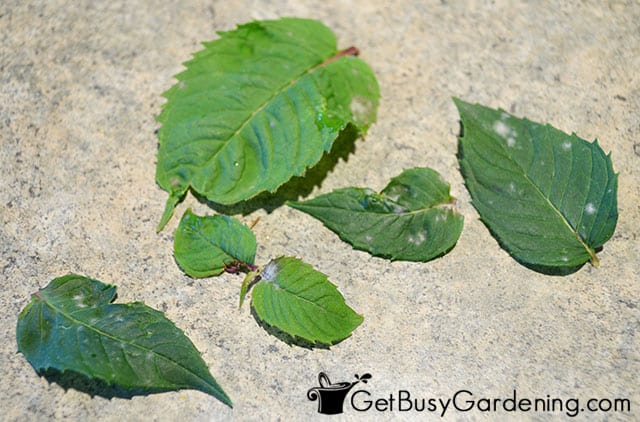
Discarding diseased bee balm leaves
Bee Balm Tea Recipe
The best part about this oswego tea recipe is that you only need two ingredients, water and the leaves. Plus, it is super easy to make. You can also add the flowers, but that’s optional.
Ingredients Needed:
- 1 cup water
- 3-4 fresh picked or dried bee balm leaves (or use as many as you like for desired flavor)
- 4-5 bee balm flower petals (optional)
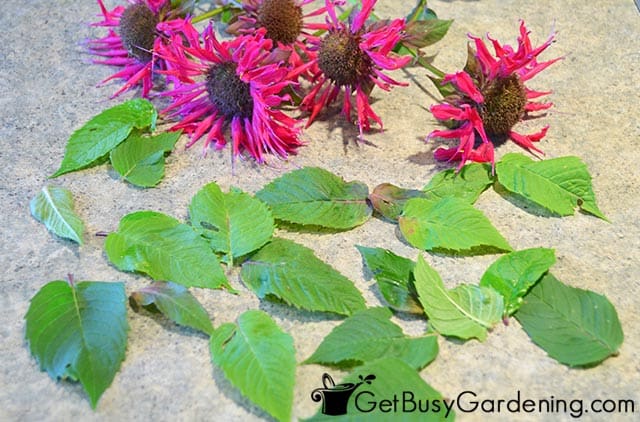
Monarda flowers and leaves ready to make tea
How To Make Bee Balm Tea
Like I said, monarda tea is super easy to make, and you’ll only need a few supplies. If you’re an avid tea drinker, you probably already have these things on hand.
Supplies Needed:
- Tea kettle, or a pot to boil water
- Infuser (optional)
- Tea cup
- Mini strainer (optional)
Steps To Make Wild Bergamot Tea
Step 1: Boil the water – Bring water to a boil in your teapot or other container.
Step 2: Fill your infuser – Put the leaves and flower petals into your tea infuser. If you don’t have an infuser, you can drop fresh leaves and flowers into the cup whole (you’ll just need to strain them out later).
Step 3: Fill the cup – Pour boiling water over the top of the tea to fill the cup, and then stir it around to remove any air bubbles that may be inside of the infuser.
Step 4: Steep your tea – Allow it to steep for 5-10 minutes, or until it reaches the desired flavor. I recommend covering the cup to keep the water warm while it steeps.
Step 5: Remove the tea from the water – Pull out the infuser, or strain the loose leaves and petals out with a fork or mini kitchen strainer.
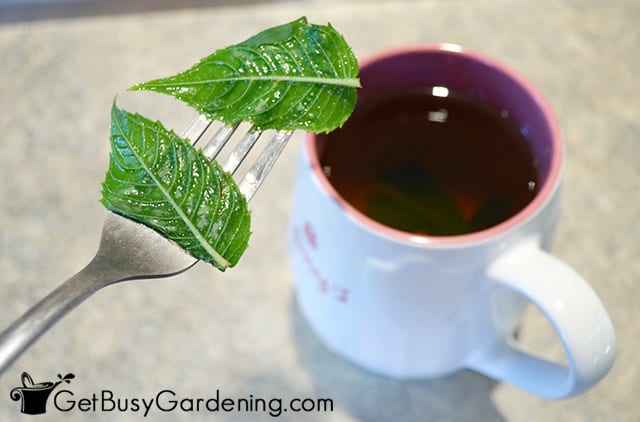
Straining my bee balm leaf tea
Step 6: Sweeten it (optional) – Add sweetener, if desired. Instead of using sugar or honey, why not try making your own homemade liquid stevia drops.
Step 7: Enjoy! – Now you can sit back, relax, and enjoy your homemade bee balm tea. Yum!
If your tea is too strong, you can add more water, and use fewer leaves next time. If it’s too weak, add a few more leaves, or allow it to steep longer.
After you make oswego tea a few times, you’ll know exactly how much you like to use for each cup.
NOTE: Though there are many known health benefits of drinking oswego tea, there are also some possible side effects. So make sure you to do your research before you decide if this is something you’d like to try.
Bee balm tea is delicious, and has many health benefits. Plus it is easy to make with only a few ingredients, and supplies you probably already have on hand. If you have monarda in your garden, you should definitely try making oswego tea.
More Garden Fresh Recipes
- How To Make Basil Pesto Using Basil Leaves
- Easy Baked Okra Fries Recipe (Oven Or Air-Fryer)
- Lavender Cookies Recipe (Using Dried Or Fresh Buds)
Share your tips for making bee balm tea in the comments below.
Print This Recipe
Bee Balm Tea
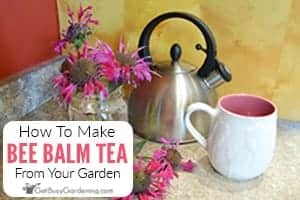
Bee balm tea (wild bergamot or oswego tea) has a delicious, slightly minty flavor. It is simple to make using either dried or fresh monarda right out of your garden.
Ingredients
- 1 cup water
- 3-4 fresh picked or dried bee balm leaves (or use as many as you like for desired flavor)
- 4-5 bee balm flower petals (optional)
Instructions
- Boil the water - Bring water to a boil in your teapot or other container.
- Fill your infuser - Put the leaves and flower petals into your tea infuser. If you don't have an infuser, you can drop fresh leaves and flowers into the cup whole (you'll just need to strain them out later).
- Fill the cup - Pour boiling water over the top of the tea to fill the cup, and then stir it around to remove any air bubbles that may be inside of the infuser.
- Steep your tea - Allow it to steep for 5-10 minutes, or until it reaches the desired flavor. I recommend covering the cup to keep the water warm while it steeps.
- Remove the tea from the water - Pull out the infuser, or strain the loose leaves and petals out with a fork or mini kitchen strainer.
- Sweeten it (optional) - Add sweetener, like sugar or honey, to taste if desired.
- Enjoy! - Now you can sit back, relax, and enjoy your homemade bee balm tea. Yum!
Notes
If your tea is too strong, you can add more water, and use fewer leaves next time. If it's too weak, add a few more leaves, or allow it to steep longer next time.
Though there are many known health benefits of drinking oswego tea, there are also some possible side effects. So make sure you to do your research before you decide if this is something you'd like to try.
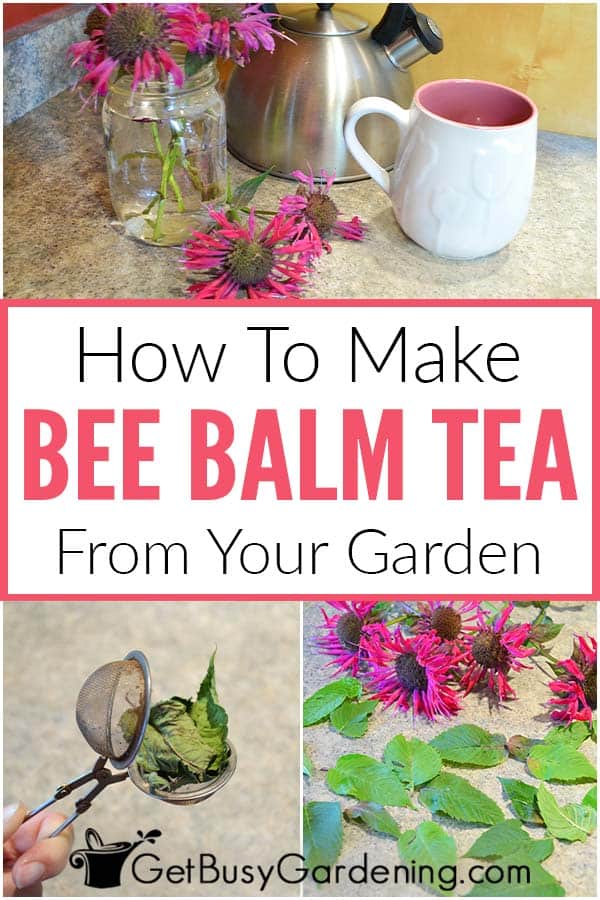

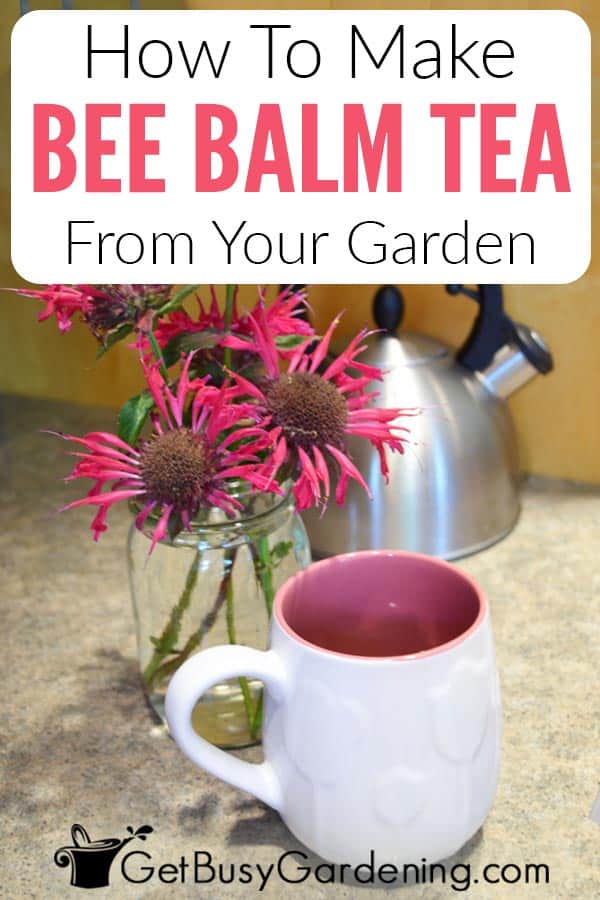
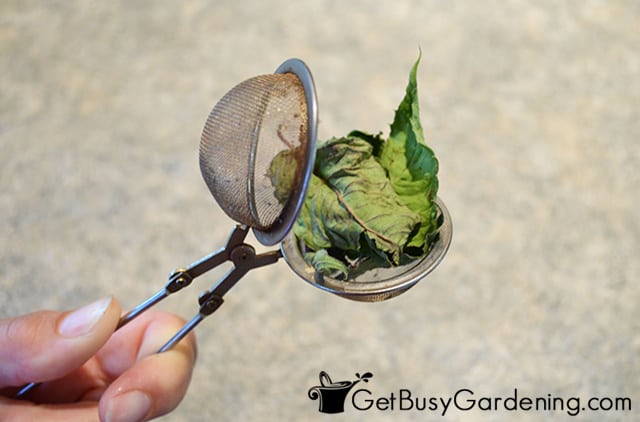
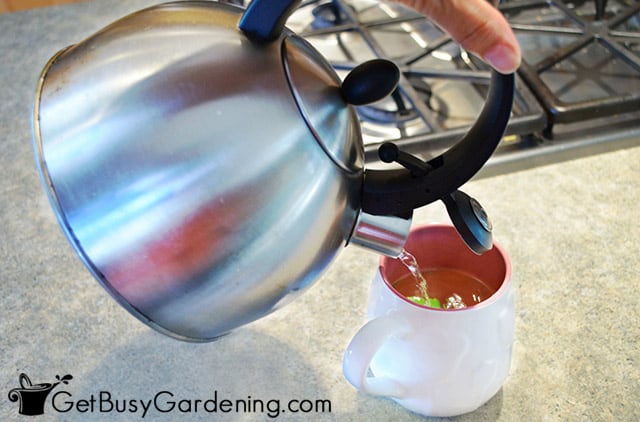

Lori Seifert says
Thank You for all your wonderful insight and recipes. I’ve been enjoying some of my homegrown organic Bee Balm Tea while reading thru your articles. You are amazing!
Amy Andrychowicz says
You’re welcome, so glad to hear you’re enjoying your homemade bee balm tea!
Marlene Perry says
Will the commercial cultivators work as well as the wild ones?
Amy Andrychowicz says
I don’t see why not.
mark puddy says
Can you make bee balm jelly?
Amy Andrychowicz says
I don’t see why not. I don’t have a recipe for you, but you can use bee balm in cooking just as you would any other herb if you want to. 🙂
Vickie Denny says
I tried the tea and found it delicious. I am going to start some plants for my tea drinking daughter. Thanks for the information.
Amy Andrychowicz says
Awesome, glad you like the bee balm tea. You’re welcome! 🙂
Steve says
What about the middle part of the flower. Can that part be used for tea as well?
Amy Andrychowicz says
I don’t see why not. I have not tried using the middle part of my bee balm flowers to make tea, so it may have a different flavor.
Vickie Denny says
How can I use the spent flowers that I cut off? They have an intoxicating aroma. I also noticed seeds coming out of them which I plan on using to increase my plants for next summer. This is my first year growing the plants and I will appreciate any tips.
Amy Andrychowicz says
If the bee balm flowers are spent, then they won’t be good to use in tea. I guess you could try floating them in water, or leaving them out to dry to enjoy their fragrance a little longer.
Frank Tabbert says
Wha] about using the flowers as well for tea?
Amy Andrychowicz says
Yes, you can use the bee balm flowers for brewing tea too, as long as they are fresh.
Linda says
Hello, I was wondering why the flower petals have to be fresh?
Amy Andrychowicz says
Sorry, I when I said “fresh”, I meant as long as the flowers aren’t spent or faded. You don’t need to use them when they’re fresh. You can dry bee balm flower petals or the leaves for later, and make tea with those too. Here’s how to dry herbs.
Janet Witman says
I love this! It’s summertime and my bee balm is exploding with aroma! Thank you for your expertise in making this special tea- making iced tea now and saving $. No more plastic jugs of store bought tea!
Amy Andrychowicz says
You’re welcome! Enjoy your DIY homegrown bee balm tea! <3
Robin Lester says
Great! Thanks so much.
Amy Andrychowicz says
You’re welcome!
Robin Lester says
There are numerous kinds of bee balm on the market. I have a white one growing. Can I use the leaves from that?
Amy Andrychowicz says
You can use any type of monarda to make tea.